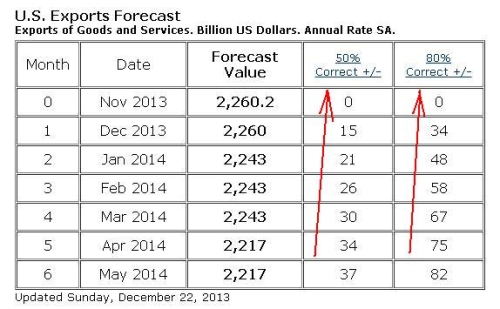Trade Balance
Definition: Trade balance, the largest component of acountry's balance of payments, is the difference in the value of its imports and exports for the reporting period.

“”What mean ???? (arrow pointed) :
50% Correct +/- And 80% Correct +/-
At the 50% Correct value there is a 50/50 chance the forecast value will be within this margin of error.
At the 80% Correct value there is a 80% chance the forecast value will be within this margin of error.
The potential range of a forecast's value is found by taking the published forecast value and both adding and subtracting the % Correct Values.
The % Correct (or error) values published are based on actual forecast performance.
For Example:
Forecast Value = 100
50% Correct Value = 10
80% Correct Value = 15
There is a 50% Chance the actual value will be between 110 and 90.
There is a 80% Chance the actual value will be between 115 and 85. “”
Export data can give an important reflection of US growth.

Imports provide an indication of domestic demand, but this figure is published later than other consumption indicators. A country has a trade deficit if it imports more than it exports, and the opposite scenario, signaled by a positive trade balance, is a trade surplus.
Why does it matter?
Despite not being the only indicator offering insight into acountry’s trade activities, the trade balance is considered to be the most useful. If an economy is exporting more than it is importing, the global demand for that economy's currency will likely increase, which will also increase that currency's value. If the balance of trade shows a surplus or even a declining deficit from the previous month, then there may be an increased demand for the national currency. It naturally happens because countries importing goods must convert their currency to the domestic currency of the exporting country.
The opposite scenario, when the report shows a growing deficit or a trend towards a decreasing trade surplus, then the increased supply of the currency could lead to a devaluation against other currencies.
The Trade Balance report influences GDP forecasts. Thishappens because net exports are a relatively volatile component of the GDP.
Trade balance gives an early indication of the net export performance for each quarter and can thus be used together with retail sales, as a leading indicator for the GDP.
Released by:
The Census Bureau and the Bureau of Economic Analysis of the Department of Commerce.
Frequency: This indicator is usually released on the second week of each month, covering the previous month's data.

